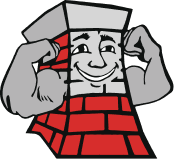What is Tuckpointing and Why is it Needed on Chimneys?
 If you have a fireplace and chimney, as you probably know, you have a beautiful design feature which increases the value and appeal of your home and provides opportunities for enjoyable moments by a cozy fire. But did you know that all masonry chimneys need repair at some point? The mortar joints become damaged due to harsh weather conditions, particularly excessive amounts of water. Moisture can even damage rock masonry, when water gets in due to weakened mortar joints. “Tuckpointing” is a repair process which stops the destructive process and provides numerous benefits.
If you have a fireplace and chimney, as you probably know, you have a beautiful design feature which increases the value and appeal of your home and provides opportunities for enjoyable moments by a cozy fire. But did you know that all masonry chimneys need repair at some point? The mortar joints become damaged due to harsh weather conditions, particularly excessive amounts of water. Moisture can even damage rock masonry, when water gets in due to weakened mortar joints. “Tuckpointing” is a repair process which stops the destructive process and provides numerous benefits.Is Tuckpointing Necessary?
While bricks on a chimney last about a century, mortar has a much shorter lifespan. Depending on how exposed the masonry is to excess water and other harsh conditions, mortar lasts about 25 years. It’s sometimes highly recommended that homeowners install a cricket, which is a compact diversion roof that prevents the chimney from being deluged in rainy weather. The layout of the roof and the position of the chimney affect how much or little water drainage contributes to erosion of the mortar joints.
When mortar joints become damaged, the most cost-effective action that a homeowner can take is to repair affected areas via tuckpointing. The alternative is to allow the mortar joints to deteriorate to the point that the chimney collapses, which makes a complete rebuild necessary–of course, the cost of a rebuild is far greater than the cost for repairs.
How is Tuckpointing Done?
The basic idea behind tuckpointing is that damaged mortar is removed, and it is replaced with fresh mortar. Tuckpointing a red brick chimney involves the following basic steps:
- Grounding or routing out the old mortar at a uniform depth.
- Filling in red mortar in the newly routed grooves.
- Cutting thin strips down the middle of the red mortar, to form grooves.
- Filling in the grooves with a mortar color which matches the original mortar on the outside of the structure.
Benefits of Tuckpointing


The appearance & stability of the chimney is seemingly brand new after tuckpointing has been completed.
Tuckpointing is really a crucial procedure, to preserve the life of a chimney. Some of the benefits of performing needed tuckpointing on chimneys follow:
- Corrosion of the mortar joints is stopped.
- Structural stability of the chimney is restored. Failing to repair mortar joints will result in a weak chimney structure which will eventually begin to lean or collapse.
- Tuckpointing helps to prevent water from entering into the chimney system. If the mortar joints are not repaired, water will seep down the chimney and sometimes between the chimney and the flue lining. Moisture can do a serious amount of unseen damage, such as cause mold, mildew, and rotting wood. Moisture can also cause the ceiling and wallpaper around the chimney to become stained.
- Tuckpointing is far more cost-effective than a complete tear-down and rebuild. The procedure allows you to avoid the expense of completely replacing the chimney structure.
- Your chimney’s masonry materials are restored to their original condition.
- The value of your home is improved when the masonry is in top condition.
One of the best reasons to contact our chimney professionals is so that you can be confident about the advice you are given. The chimney sweep profession is currently unregulated, which means that anyone can set up shop to perform the work, even if they have no experience or knowledge. It also means that scammers work hard to dupe consumers into paying up front for repairs they say are necessary, and then the work is never done. We will provide a reliable assessment and answer any and all of your questions about your chimney and venting systems and about tuckpointing and why it is or is not needed on your chimney.
Northeastern Chimney, Inc
37 Cody Street, West Hartford, CT 06110
Phone: 860-233-5770


